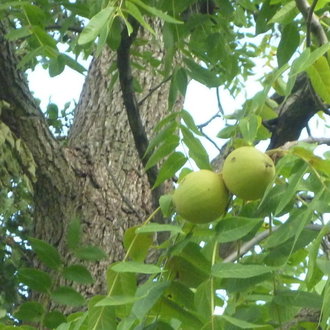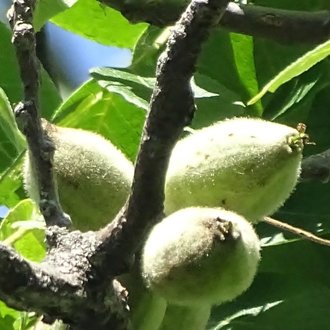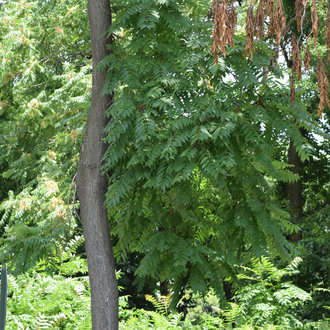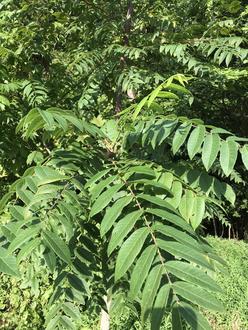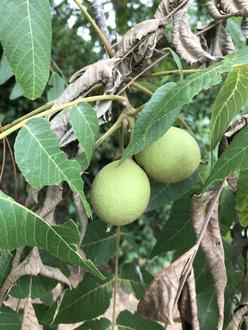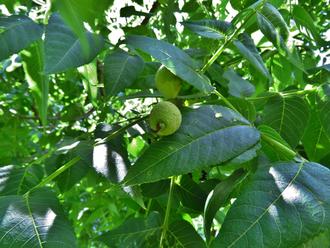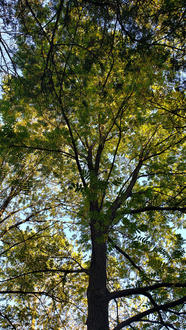Eastern Black Walnut (Juglans nigra L.)
↑Summary
A widespread and common tree native to eastern North America, valued for its nuts as well as its wood.
↑Range - Expand
| Legend | Color |
| Native | |
| Introduced | |
| Expanded | |
| Native or Not Present | |
| Introduced or Not Present | |
| Native or Expanded | |
| Native or Expanded or Not Present |
This map is based on our research. We have checked its accuracy to Level 3 ecoregions. Although this plant occurs somewhere in each of these regions, it may only occur in a small part of some or all of them.
This species is now found well outside its native range. We marked the populations in New England, eastern ND, southeastern CO, and eastern NM as expansions because they are near this species' native range. All populations farther west, we marked as introductions because they are separated by larger distances that include habitats where this species likely could not survive in the wild.
↑Similar Plants
↑Habitat
Prefers full sun, moist conditions, and fertile soil. Found on a range of sites but most common and vigorous on deep, well-drained soils rich in nutrients, especially limestone soils. Growth is slowed on waterlogged soil or dry sites. Prefers similar soils to those ideal for Western agriculture.
Most common in bottomlands and floodplains. An early successional species, intolerant of shade and often not persisting long in forests in the absence of disturbance.
Well-adapted to fire, both in terms of fire-resistance and ability to rapidly colonized burned sites.
↑Life Cycle
Nuts germinate after a period of cold dormancy, usually after being buried by a squirrel. Some nuts do not germinate in the first year.
Seedlings quickly establish a deep taproot with numerous branching lateral roots. The first few leaves have fewer leaflets than normal, but quickly the new shoot has leaves more typical of this species. Seedlings are shade-intolerant and require high light conditions to survive, although there is enough energy stored in the nut for them to sometimes push up through competing vegetation to reach light.
Relative to other trees, leafs out relatively late in spring. Begins dropping leaves early, often starting mid-summer. Drought, insects, or disease causes trees to drop more leaves earlier, often with little to no long-term detriment to the tree.
Growth is rapid, and trees begin producing nuts around 8 years of age. Seed production is irregular, with large crops produced on average every 2 out of 5 years. Seed production peaks around 30 years and continues to about 130 years. Seeds mature in fall. Seeds are heavy and primarily dispersed by squirrels.
Younger trees are more likely to be top-killed by fire, but more likely to resprout vigorously from the root crown. Trees older than about 30 years are usually more resistant to fire, but less likely to resprout if top-killed. Resprouting is often vigorous on younger trees following cutting, making these plants somewhat hard to remove when growing unwanted in a garden setting.
↑Uses
Eastern black walnut is a highly desired wood for woodworking, due to its ease of working and rich, dark color, and good strength and physical properties. It is used in furniture, cabinetry, paneling, and various small objects. This species rapid growth and wide distribution makes it one of the more sustainable wood sources, although its populations have still be harmed by overharvesting due to the wood's desirability. More on Black walnut in the wood database.
The nuts of black walnut are edible, although they are more difficult to crack and slightly more bitter relative to English walnuts. Because of its strong flavor, it is often used as an ice cream flavor, where the sweetness of the ice cream balances the nut's bitterness.
Historically, black walnut has also been used as a dye plant, producing a dark brown color. It is sometimes still used as such by those interested in plant-based dyes or historically-accurate dying.
↑Links & External Resources
• Black Walnut | The Wood Database (About This Site)
• Black Walnut | Fire Effects Information System (FEIS) (About This Site)
• Juglans nigra (Black Walnut) | Illinois Wildflowers (About This Site)
• Juglans nigra (Eastern Black Walnut) | USDA PLANTS Database (About This Site)
• Juglans nigra | Go Botany (About This Site)
• Juglans nigra (Black Walnut) | Missouri Botanical Garden Plant Finder (About This Site)
• Black Walnut | Virginia Tech Dendrology Factsheets (About This Site)
• Black Walnut | Silvics of North America (About This Site)
• Juglans nigra | Biota of North America Project (BONAP) (About This Site)
• Juglans nigra | NatureServe Explorer (About This Site)
• Juglans nigra | Flora of North America (About This Site)
• Juglans nigra | Missouri Plants (About This Site)
• Black Walnut | Maryland Biodiversity Project (About This Site)
• Juglans nigra L. (Black Walnut) | Digital Atlas of the Virginia Flora (About This Site)



